HONDA S2000 2000 1.G Owner's Guide
Manufacturer: HONDA, Model Year: 2000, Model line: S2000, Model: HONDA S2000 2000 1.GPages: 273, PDF Size: 21.58 MB
Page 31 of 273
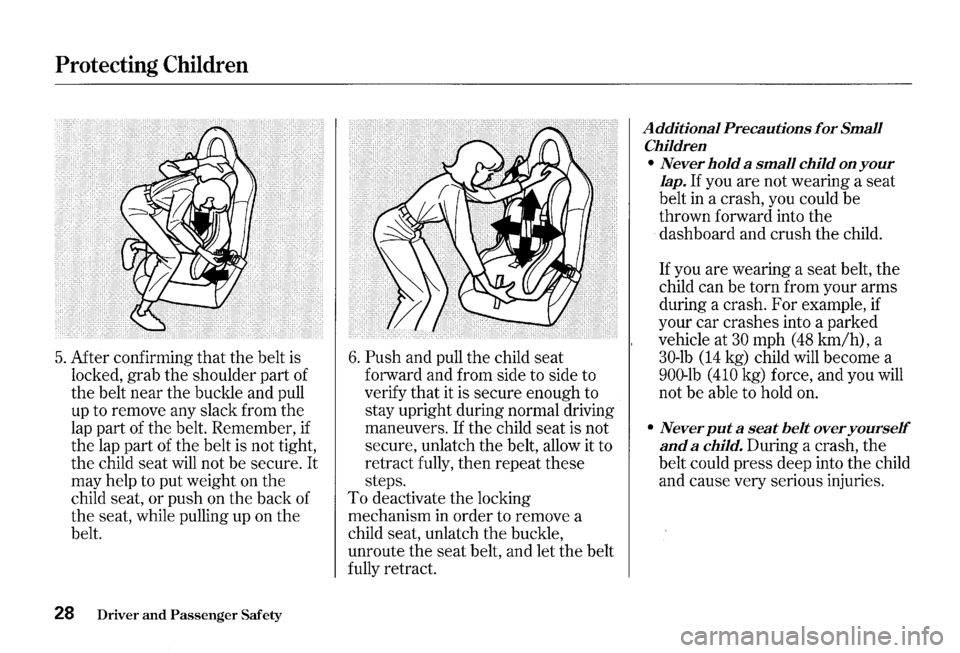
Protecting Children
5. After confirming that the belt is
locked, grab the shoulder part of
the belt near the buckle and pull
up to remove any slack from the
lap part of the belt. Remember,
if
the lap part of the belt is not tight,
the child seat
will not be secure. It
may help to put weight on the
child seat, or push on the back of
the seat, while pulling up on the
belt.
28 Driver and Passenger Safety
6. Push and pull the child seat
forward and from side to side to
verify that it is secure enough to
stay upright during normal driving
maneuvers.
If the child seat is not
secure, unlatch the belt, allow it to
retract fully,
then repeat these
steps.
To deactivate the locking
mechanism
in order to remove a
child seat, unlatch
the buckle,
unroute the seat belt, and let the belt
fully retract.
Additional Precautions for Small
Children
• Never hold a small child on your
lap. If you are not wearing a seat
belt
in a crash, you could be
thrown forward into the
dashboard and crush the child.
If you are wearing a seat belt, the
child can be torn from your arms
during a crash. For example,
if
your car crashes into a parked
vehicle at
30 mph ( 48 km/h), a
30-lb (14 kg) child will become a
900-lb (410 kg) force, and you will
not be able to hold on.
• Never put a seat belt over yourself
and a child. During a crash, the
belt could press deep into the child
and cause very serious injuries.
Page 32 of 273
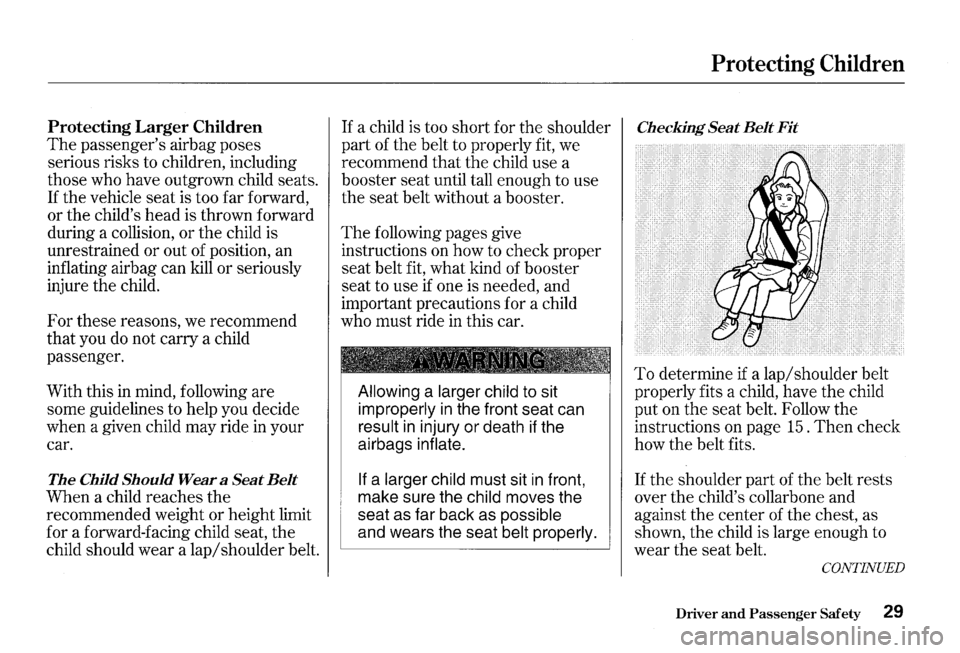
Protecting Larger Children
The passenger's airbag poses
serious risks to children, including
those who have outgrown child seats.
If the vehicle seat is too far forward,
or the child's head is thrown forward
during a collision, or the child is
unrestrained or out of position, an
inflating airbag can kill or seriously
injure the child.
For these reasons, we recommend
that you
do not carry a child
passenger.
With this
in mind, following are
some guidelines to help you decide
when a given child may ride in your
car.
The Child Should Wear a Seat Belt
When a child reaches the
recommended weight or height limit
for a forward-facing child seat, the
child should wear a lap/shoulder belt.
If a child is too short for the shoulder
part of the belt to properly fit, we
recommend that the child use a
booster seat until tall enough to use
the seat belt without a booster.
The following pages give
instructions on how to check proper
seat belt fit, what kind of booster
seat to use
if one is needed, and
important precautions for a child
who must ride in this car.
Allowing a larger child to sit
improperly in the front seat can
result in injury or death if the
airbags
inflate.
If
a larger child must sit in front,
make sure the
child moves the
seat as far back as
possible
and wears the seat belt properly.
Protecting Children
Checking Seat Belt Fit
To determine if a lap/shoulder belt
properly fits a child, have the child
put on the seat belt. Follow the
instructions on page 15.
Then check
how the belt fits.
If the shoulder part of the belt rests
over the child's collarbone and
against the center of the chest, as
shown, the child is large enough to
wear the seat belt.
CONTINUED
Driver and Passenger Safety 29
Page 33 of 273
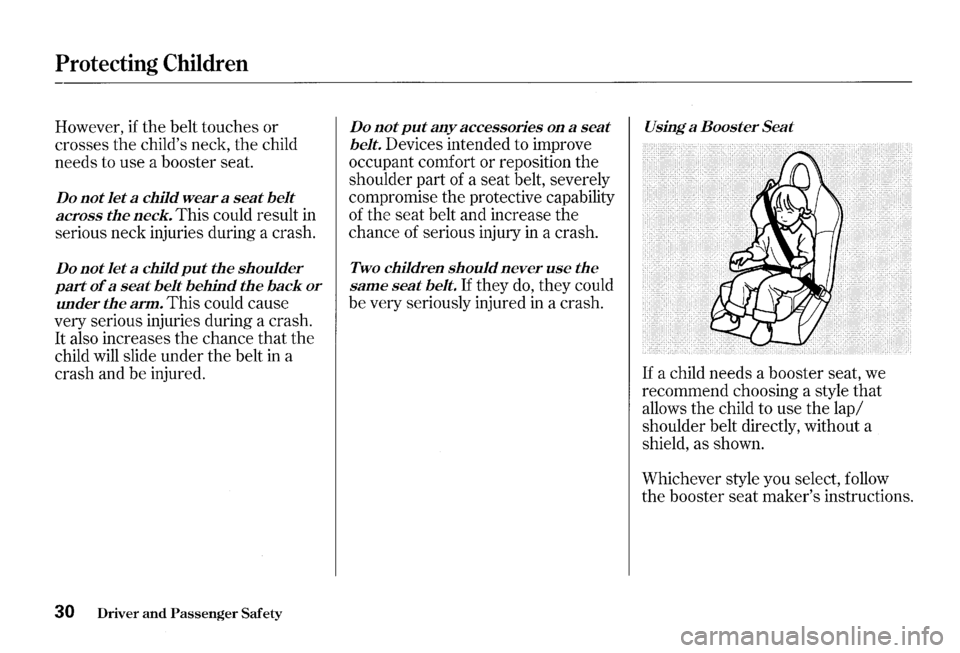
Protecting Children
However, if the belt touches or
crosses the child's neck,
the child
needs to use a booster seat.
Do not let a child wear a seat belt
across the neck. This could result in
serious neck injuries during a crash.
Do not let a child put the shoulder
part of a seat belt behind the back or
under the arm. This could cause
very serious injuries during a crash.
It also increases the chance that the
child will slide under the belt in a
crash and be injured.
30 Driver and Passenger Safety
Do not put any accessories on a seat
belt. Devices intended to improve
occupant comfort or reposition the
shoulder part of a seat belt, severely
compromise the protective capability
of the seat belt and increase the
chance of serious injury
in a crash.
Two children should never use the
same seat belt. If they do, they could
be very seriously injured
in a crash.
Using a Booster Seat
If a child needs a booster seat, we
recommend choosing a style that
allows the child to use the
lap/
shoulder belt directly, without a
shield, as shown.
Whichever style you select, follow
the booster seat maker's instructions.
Page 34 of 273
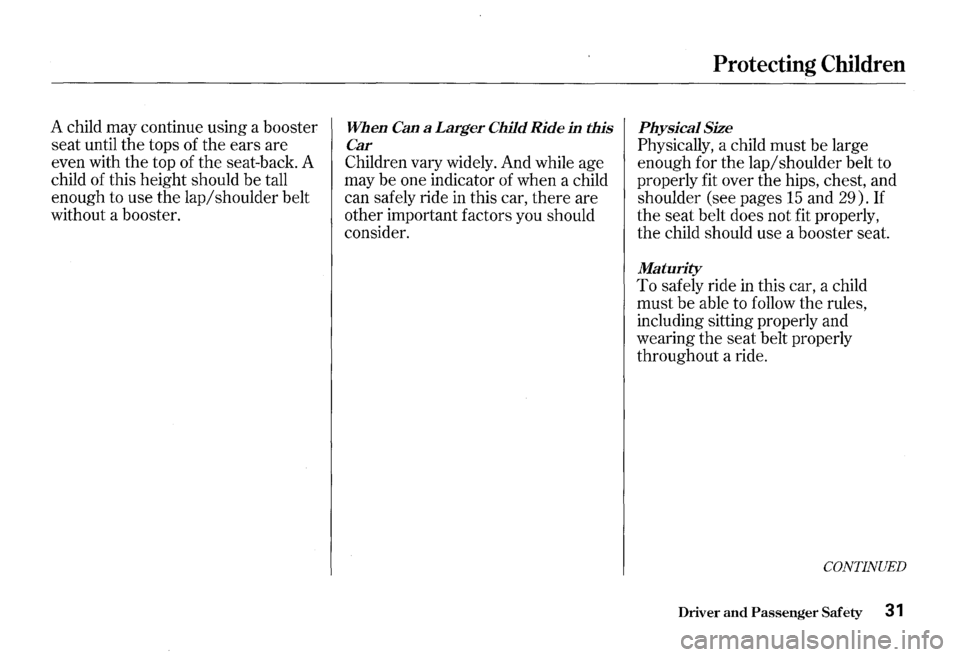
A child may continue using a booster
seat until the tops of the
ears are
even with the top of
the seat-back. A
child of this height should be tall
enough to use the
lap/ shoulder belt
without a booster.
JVhen Can a Larger Child Ride in this
Car
Children vary widely. And while age
may be one indicator of when a child
can safely ride in this car, there are
other important factors you should
consider.
Protecting Children
Physical Size
Physically, a child must be large
enough for the
lap/ shoulder belt to
properly fit over the hips, chest, and
shoulder (see pages
15 and 29). If
the seat belt does not fit properly,
the child should use a booster seat.
Maturity
To safely ride in this car, a child
must be able to follow the rules,
including sitting properly and
wearing
the seat belt properly
throughout a ride.
CONTINUElJ
Driver and Passenger Safety 31
Page 35 of 273
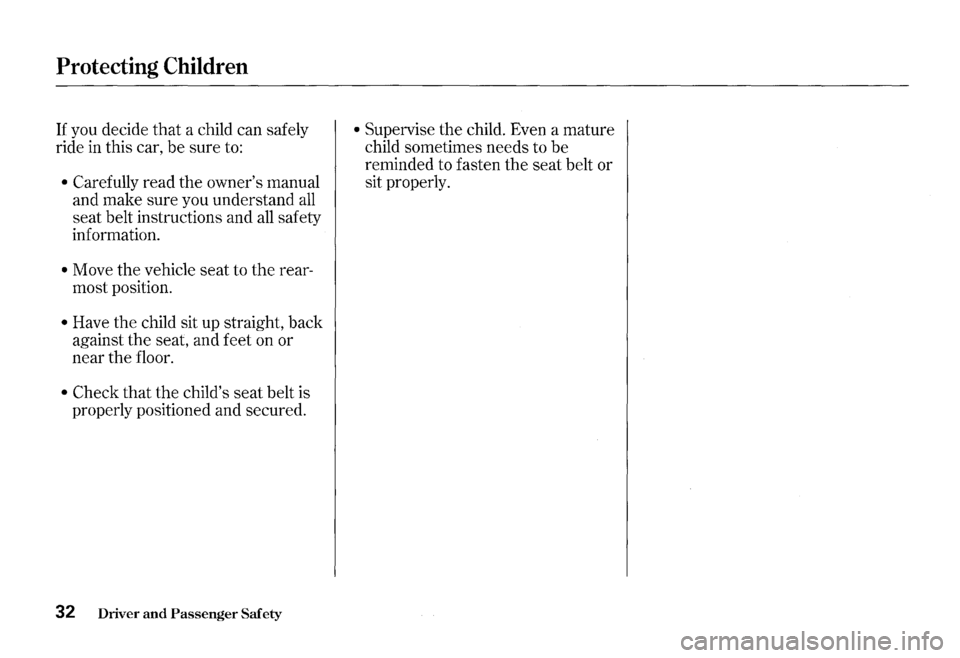
Protecting Children
If you decide that a child can safely
ride in this car, be sure to:
• Carefully read the owner's manual
and make sure you understand
all
seat belt instructions and all safety
information.
• Move the vehicle seat to the rear
most position.
• Have the child sit up straight, back
against the seat, and feet on or
near the floor.
• Check that the child's seat belt is
properly positioned and secured.
32 Driver and Passenger Safety
• Supervise the child. Even a mature
child sometimes needs to be
reminded to fasten the seat belt or
sit properly.
Page 36 of 273
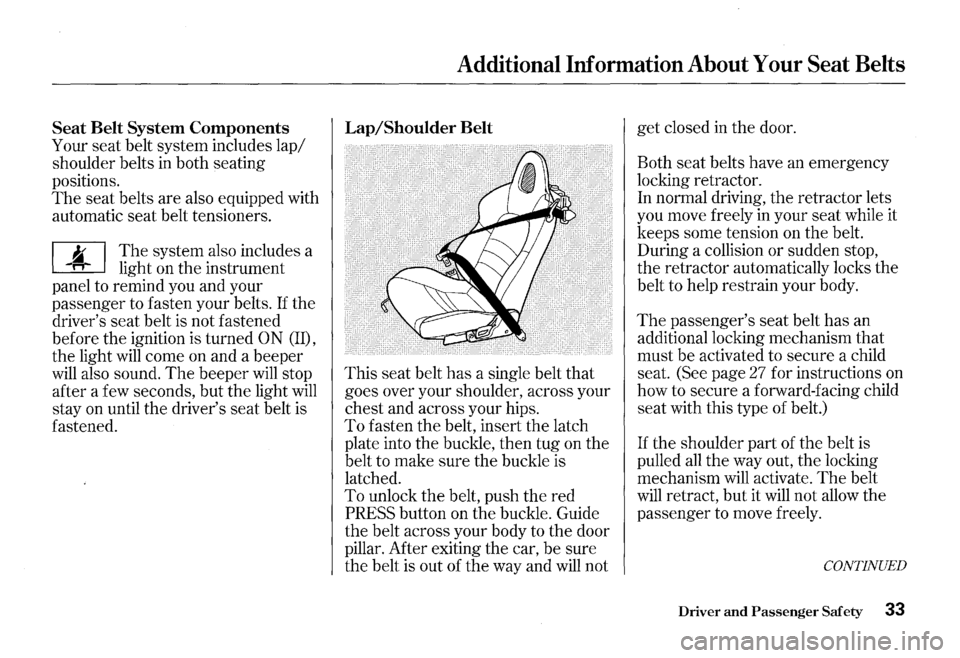
Seat Belt System Components
Your seat belt system includes lap/
shoulder belts in both seating
positions.
The seat belts are also equipped with
automatic seat belt tensioners.
~ The system also includes a
l±J light on the instrument
panel to remind you and your
passenger to fasten your belts.
If the
driver's seat belt is not fastened
before the ignition is turned
ON (II),
the light will come on and a beeper
will also sound.
The beeper will stop
after a few seconds,
but the light will
stay on until the driver's seat belt is
fastened.
Additional Information About Your Seat Belts
Lap/Shoulder Belt
This seat belt has a single belt that
goes over your shoulder, across your
chest and across your hips.
To fasten the belt, insert the latch
plate into the buckle, then tug on the
belt to make sure the buckle is
latched.
To unlock the belt, push the red
PRESS button on the buckle. Guide
the belt across your body to the door
pillar. After exiting the car, be sure
the belt is out of
the way and will not
get closed in the door.
Both seat belts have an emergency
locking retractor.
In normal driving,
the retractor lets
you move freely
in your seat while it
keeps some tension on the belt.
During a collision or sudden stop,
the retractor automatically locks the
belt to help restrain your body.
The passenger's seat belt has an
additional locking mechanism that
must be activated to secure a child
seat. (See page
27 for instructions on
how to secure a forward-facing child
seat with this type of belt.)
If the shoulder part of the belt is
pulled
all the way out, the locking
mechanism will activate.
The belt
will retract, but it will not allow the
passenger to move freely.
CONTINUED
Driver and Passenger Safety 33
Page 37 of 273
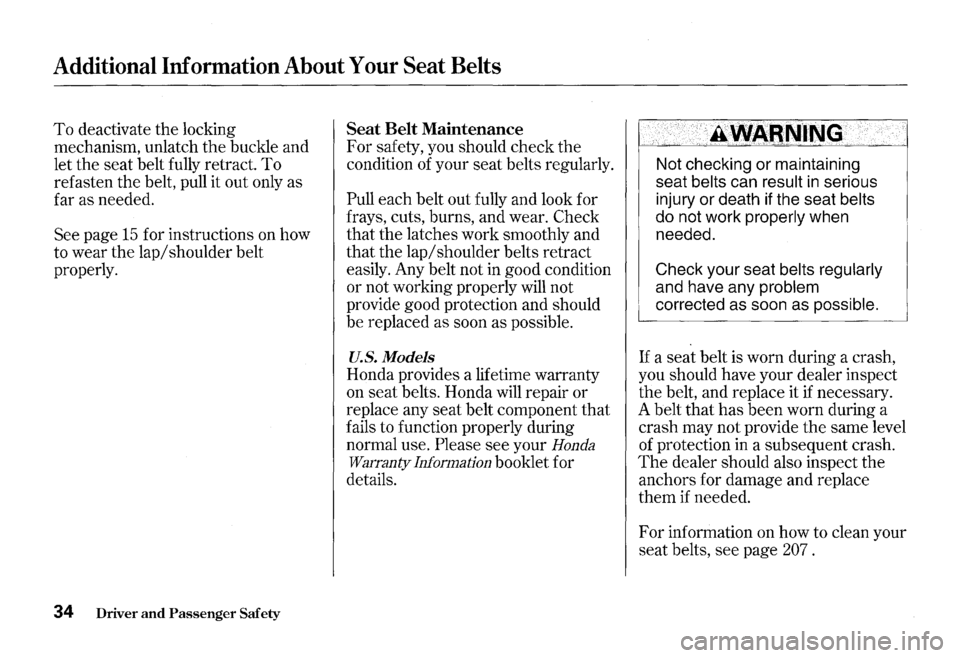
Additional Information About Your Seat Belts
To deactivate the locking
mechanism, unlatch
the buckle and
let the seat belt fully retract.
To
refasten the belt, pull it out only as
far as needed.
See page
15 for instructions on how
to wear the lap/shoulder belt
properly.
34 Driver and Passenger Safety
Seat Belt Maintenance
For safety, you should check the
condition of your seat belts regularly.
Pull each belt out fully and look for
frays, cuts, burns, and wear. Check
that the latches work smoothly and
that the lap/shoulder belts retract
easily. Any belt not
in good condition
or not working properly will not
provide good protection and should
be replaced as soon as possible.
U.S. Models
Honda provides a lifetime warranty
on seat belts. Honda
will repair or
replace any seat belt component
that
fails to function properly during
normal use.
Please see your Honda
WmTanty Information
booklet for
details.
·.
Not checking or maintaining
seat
belts can result in serious
injury or death if the seat
belts
do not work properly when
needed.
Check your seat
belts regularly
and have any problem
corrected as soon as possible.
If a seat belt is worn during a crash,
you should have your dealer inspect
the belt, and replace it
if necessary.
A belt that
has been worn during a
crash may not provide
the same level
of protection in a subsequent crash.
The dealer should also inspect the
anchors for damage and replace
them if needed.
For information on how to clean your
seat belts, see page
207 .
Page 38 of 273
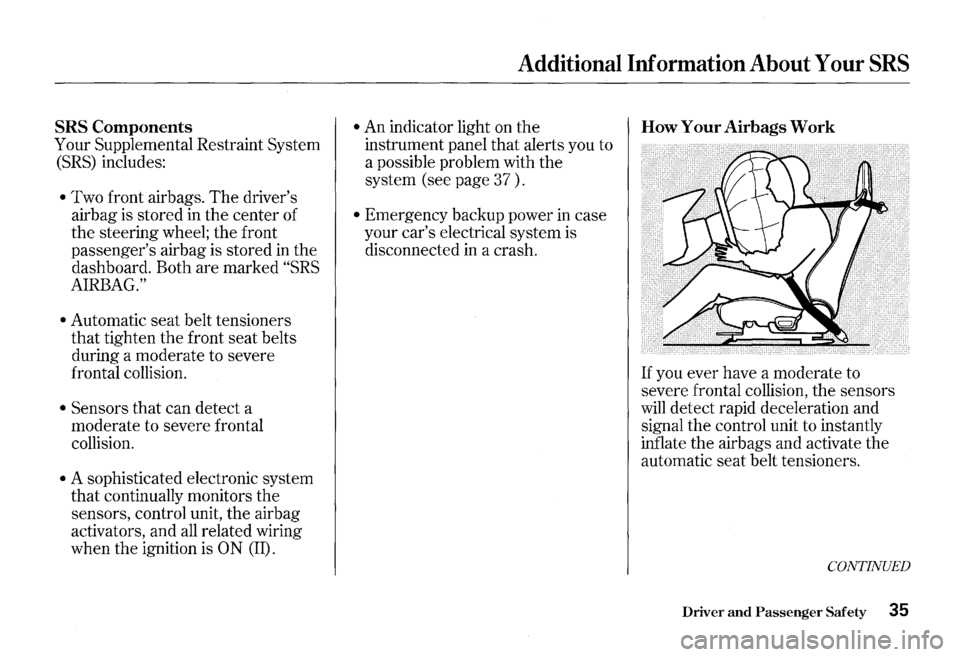
SRS Components
Your Supplemental Restraint System
(SRS) includes:
• Two front airbags. The driver's
airbag is stored
in the center of
the steering wheel; the front
passenger's airbag is stored
in the
dashboard. Both are marked
"SRS
AIRBAG."
•
Automatic seat belt tensioners
that tighten
the front seat belts
during a moderate to severe
frontal collision.
• Sensors that can detect a
moderate to severe frontal
collision.
• A sophisticated electronic system
that continually monitors the
sensors, control unit, the airbag
activators, and all related wiring
when the ignition is
ON (II).
Additional Information About Your SRS
• An indicator light on the How Your Airbags Work
instrument panel that alerts you to
a possible problem with the
system (see page
37).
• Emergency backup power in case
your car's electrical system
is
disconnected in a crash.
If you ever have a moderate to
severe frontal collision, the sensors
will detect rapid deceleration and
signal the control unit to instantly
inflate the airbags and activate the
automatic seat belt tensioners.
CON11NUED
Driver and Passenger Safety 35
Page 39 of 273
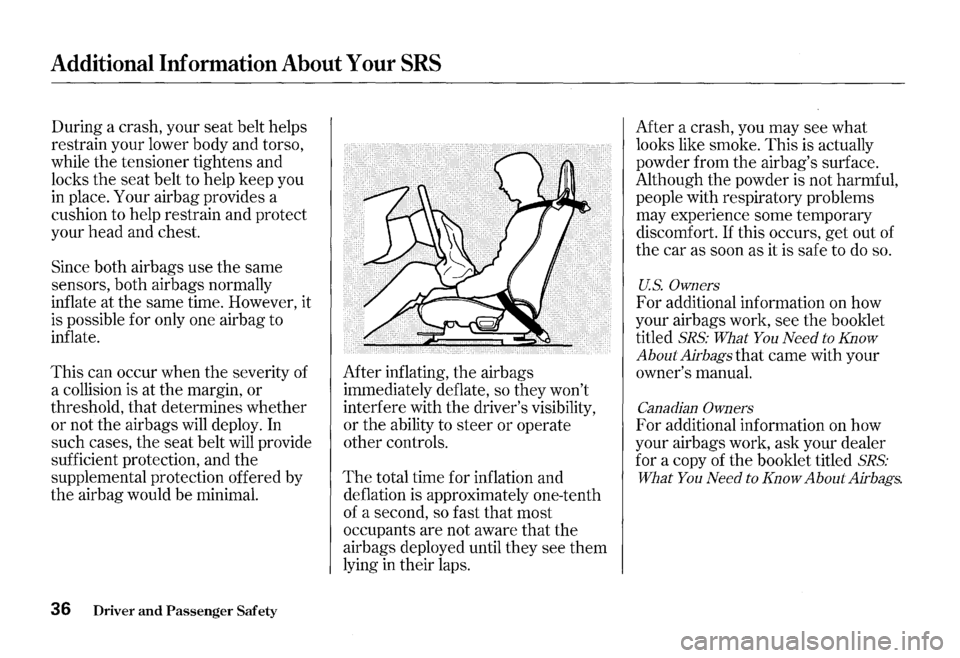
Additional Information About Your SRS
During a crash, your seat belt helps
restrain your lower body and torso,
while the tensioner tightens and
locks
the seat belt to help keep you
in place.
Your air bag provides a
cushion to help restrain and protect
your head and chest.
Since both airbags use the same
sensors, both airbags normally
inflate at the same time. However, it
is possible for only one air bag to
inflate.
This can occur when the severity of
a collision is at the margin, or
threshold, that determines whether
or not the airbags will deploy. In
such cases, the seat belt will provide
sufficient protection, and the
supplemental protection offered by
the air bag would be minimal.
36 Driver and Passenger Safety
Mter inflating, the airbags
immediately deflate, so they won't
interfere with the driver's visibility,
or the ability to
steer or operate
other controls.
The total time for inflation and
deflation is approximately one-tenth
of a second, so fast
that most
occupants are not aware that the
airbags deployed until they see
them
lying in their laps.
Mter a crash, you may see what
looks like smoke. This is actually
powder from the airbag's surface.
Although the powder is not harmful,
people with respiratory problems
may experience some temporary
discomfort.
If this occurs, get out of
the car as soon as it is safe to
do so.
U.S. Owners
For additional information on how
your airbags work, see the booklet
titled
SRS· What You Need to Know
About Airbags that came with your
owner's manual.
Canadian Owners
For additional information on how
your airbags work, ask your dealer
for a copy of the booklet titled
SRS:
What
You Need to Know About Airbags.
Page 40 of 273
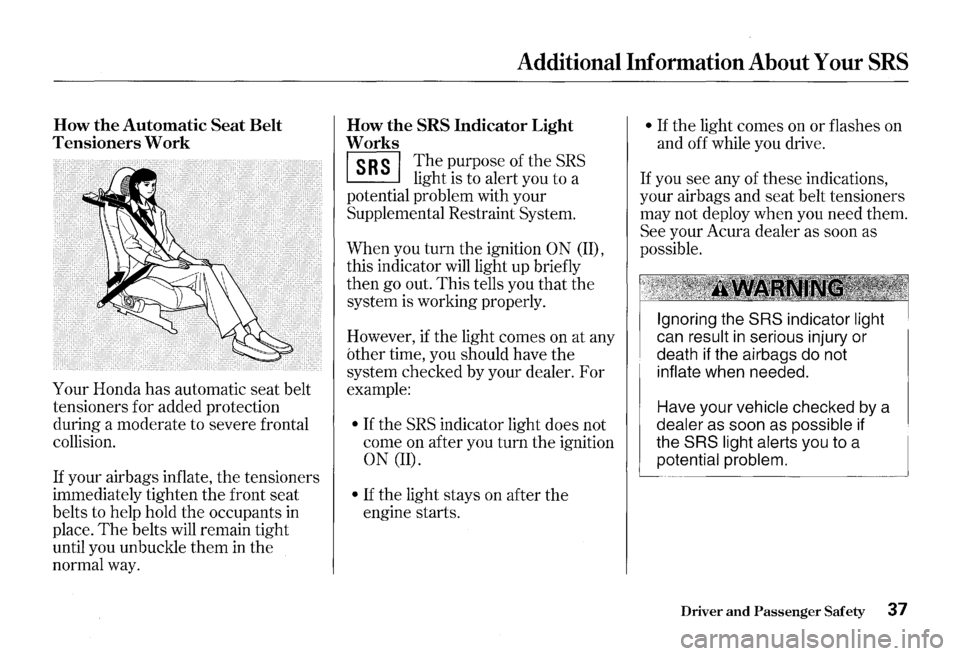
How the Automatic Seat Belt
Tensioners Work
Your Honda has automatic seat belt
tensioners for added protection
during a moderate to severe frontal
collision.
If your airbags inflate, the tensioners
immediately tighten the front
seat
belts to help hold the occupants in
place.
The belts will remain tight
until you unbuckle
them in the
normal way.
Additional Information About Your SRS
How the SRS Indicator Light
Works
~ ~he J?Urpose of the SRS
~ hght 1s to alert you to a
potential problem with your
Supplemental Restraint System.
When you turn the ignition
ON (II),
this indicator will light up briefly
then go out. This tells you that the
system is working properly.
However,
if the light comes on at any
other time, you should have the
system checked by your dealer. For
example:
• If the SRS indicator light does not
come on after you turn the ignition
ON(II).
• If the light stays on after the
engine starts.
• If the light comes on or flashes on
and off while you drive.
If you see any of these indications,
your airbags and
seat belt tensioners
may not deploy when you need them.
See your Acura dealer as soon as
possible.
Ignoring the SRS indicator light
can result in serious injury or
death if the airbags do not
inflate when needed.
Have your
vehicle checked by a
dealer as soon as possible if
the SRS
light alerts you to a
potential problem.
Driver and Passenger Safety 37